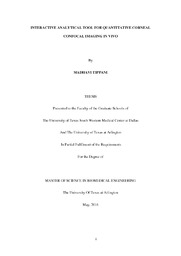
ATTENTION: The works hosted here are being migrated to a new repository that will consolidate resources, improve discoverability, and better show UTA's research impact on the global community. We will update authors as the migration progresses. Please see MavMatrix for more information.
Show simple item record
| dc.contributor.advisor | Liu, Hanli | |
| dc.contributor.advisor | Petroll, Matthew | |
| dc.creator | Tippani, Madhavi | |
| dc.date.accessioned | 2016-09-28T18:48:46Z | |
| dc.date.available | 2016-09-28T18:48:46Z | |
| dc.date.created | 2016-05 | |
| dc.date.issued | 2016-05-19 | |
| dc.date.submitted | May 2016 | |
| dc.identifier.uri | http://hdl.handle.net/10106/25929 | |
| dc.description.abstract | The objective of this study was to develop an interactive software application for image reconstruction and analysis of the corneal data from an in vivo confocal microscope (Heidelberg Retinal Tomograph with Rostock Corneal Module, HRT-RCM). The optical sectioning ability of confocal microscopy gives high resolution optical section images at different depths within a thick tissue, thereby eliminating the need for physical sectioning. This ability of 4-dimensional (x,y,z and t) imaging makes confocal microscopy uniquely suited for imaging the cornea at the cellular level. The new program was developed to overcome the drawbacks of the original application “Confo” developed in the C++ programming environment. Since it was developed in C++, the original program was cumbersome and modifications or addition of new features required extensive programming experience in C++. The new application was developed on MATLAB platform because of its well-known user-friendly programming environment, extensive tool box for image processing and analysis, and more widespread availability and use.
The MATLAB tool allows user to input 3-D confocal files produced by the HRT-RCM. A series of images parallel to the epithelium of the cornea acquired in a sequence are stored in a single “.vol” (Volume) file, with each image having header information (image number and timestamp for depth calculation) of 384 bytes, followed by actual image data of 384X384 pixels. This new software decodes the volume file, and provides interactive visualization of the 3-D confocal dataset. In addition, a plot of image versus depth is generated using a user-selected region of interest. This curve can be used for quantitative measurements of sub corneal layers (epithelial, stromal and endothelial thicknesses) and assessment of stromal haze. These strategies can help the corneal researchers and clinicians to visualize and quantify the cellular events of corneal wound healing following incisional surgery, endothelial keratoplasty, corneal crosslinking procedures, infectious keratitis and refractive surgical procedures such as photorefractive keratectomy (PRK) and laser-assisted in situ keratomileusis (LASIK).
A new feature of this tool is to pick the center of the desired Region Of Interest (ROI) from the image stack for curve calculation, whereas confo always centers the ROI on the center of the image for curve calculation. Different sizes and positions of ROIs are sometimes required while assessing a more convex cornea.
In vivo corneal examinations of rabbit cornea (on different days of wound healing) and of mouse cornea are performed and presented to demonstrate the above mentioned capabilities of the tool. | |
| dc.format.mimetype | application/pdf | |
| dc.language.iso | en_US | |
| dc.subject | Confocal | |
| dc.title | Interactive Analytical Tool for Quantitative Corneal Confocal Imaging in vivo | |
| dc.type | Thesis | |
| dc.degree.department | Bioengineering | |
| dc.degree.name | Master of Science in Biomedical Engineering | |
| dc.date.updated | 2016-09-28T18:50:53Z | |
| thesis.degree.department | Bioengineering | |
| thesis.degree.grantor | The University of Texas at Arlington | |
| thesis.degree.level | Masters | |
| thesis.degree.name | Master of Science in Biomedical Engineering | |
| dc.type.material | text | |
| dc.creator.orcid | 0000-0002-9601-7215 | |
Files in this item
- Name:
- TIPPANI-THESIS-2016.pdf
- Size:
- 2.231Mb
- Format:
- PDF
This item appears in the following Collection(s)
Show simple item record


